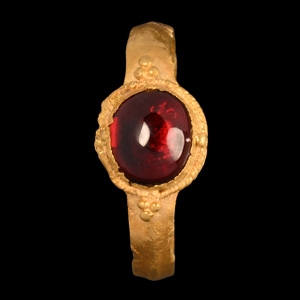Home > Auctions > 23 - 27 May 2023
Ancient Art, Antiquities, Natural History & Coins
Auction Highlights:
Acquired from Antoine Boccador-Lieveaux, 2005.
Ex central London gallery.
Accompanied by an academic report by Dr Raffaele D’Amato.
This lot has been checked against the Interpol Database of stolen works of art and is accompanied by search certificate no.11739-202053.
Cf. D’Emilio, J., ’The Royal Convent of Las Huelgas: Dynastic Politics, Religious Reform and Artistic Change in Medieval Castile’ in Studies in Cistercian Art and Architecture 6, Kalamazoo, 2005, pp.191-282, figs.11,13,15 (window Capital of Saint Andres de Arroyo, apse and South Chapel), 34 (Noyon cathedral), 36 (Laon cathedral); Igarashi-Takeshita, M., ‘Les lions dans la sculpture romane en Poitou’ in Cahiers de civilisation médiévale, 23e année (n°89), Janvier-mars 1980, pp.37-54.
The iconography of this capital is probably associated with the biblical story of Daniel in the lion's den. Capitals like this were part of an extensive decorative program which characterised Spanish and the French churches especially in the late 12th century A.D., with the advent of the Cistercian style. Foliate capitals ornamented the churches of Las Claustrillas, Aguilar, Gama, and other Christian sites of Southern France and Northern Spain. Capitals decorated with similar acanthus foliage can be found in churches in Burgundy, for instance at Avallon, Vezelay, and Donzy-le-Pré. However, figurative elements of the old Romanesque art also persisted.
Acquired 1990s-early 2000s.
East Anglian private collection.
French private collection.
with Jean-Charles D'Ornano, 16 January 2022, lot 233.
Ex central London gallery.
Accompanied by an academic report by Dr Raffaele D’Amato.
This lot has been checked against the Interpol Database of stolen works of art and is accompanied by search certificate no.11749-202077.
Cf. an embroidered panel, part of a dalmatic in the Metropolitan Museum of Art, accession no. 64.101.1381, in Hartt, F., The Metropolitan Museum of Art. Vol. 4, The Renaissance in Italy and Spain,New York, 1988, pp.67-69, for comparison.
The dalmatic (liturgical vestment derived from the Late Roman garment with the same name) was worn by the deacons in Latin Catholic Church. This dress, mainly used in the Holy Liturgy, was often decorated in silk and gold embroidery, and splendid specimens were realised by the Italian workshops of the Florentine Republic, one of the richest Italian states of the Renaissance.
Found at Kirkleavington near Yarm, North Riding of Yorkshire, UK, in 1847.
Accompanying label describes it as ‘found in constructing the Leeds and Thirsk Railway, near Kirkleavington, Co. York. Communicated by John Bourne, Esq. Engineer to the Company, Leeds’.
Accompanied by a manuscript letter of September 17th 1847 from Mr Histon Longstaffe discussing the text, with later amendments date 1854.
This lot has been checked against the Interpol Database of stolen works of art and is accompanied by searcher certificate no. 200593.
Cf. a near identical purse frame in the Victoria and Albert Museum, accession number M.14-1968.
Metal purse frames of this type were a luxury personal accessory of late Middle Ages and early Renaissance period (about 1450-1500). They were decorated with niello. In this technique the metalworker engraved a pattern or design onto highly polished metal and filled the incised lines with a hard black alloy. Religious inscriptions were incised to invoke the divine protection. A fragmentary purse-frame in the MOL [ID 4452] containing this same portion of the Apostles Creed enables us to correct the 19C reading INFERVN to IN IESVN ('in Jesus')
Ex 6th Earl of Arran (Sir Arthur Gore), 1920.
Cf. de Gray Birch, W., Seals in the Department of Manuscripts in the British Museum, Vol. 6, p.275, no. 12,791, pl. VII; D'Arcq, no. 6049 (from a Bull dated 1255 AD).
Found by eye in Widford Parish in the 1970s, next to the old Salt Way to the Royal Parish of Bampton, Oxfordshire, UK.
Accompanied by a print out about Widford and the church of St. Oswald, Oxon.
Acquired from a London gallery in 1990.
Ex property of a North London gentleman.
Cf. Leahy and Lewis, Finds Identified, BM, 2018, pp.138-139, for similar examples; Hammond, A., Benet's Artefacts, Coggeshall, 2021, pp.703, 729.
A wide range of people would have used a seal, from the monarch to small landowners and tradespeople, anyone with a need for business or legal documents. Individuals had personal seals, but seals were also used by official bodies such as town corporations, trade and religious guilds, cathedrals, abbeys and monasteries, having religious inscriptions like in this one.
Found while searching with a metal detector in Bossingham, Kent, UK, by Alan John Punyer on 14 September 2000.
Disclaimed under the Treasure Act with reference no. M&ME 297.
Accompanied by a copy of page 61 of the Treasure Annual Report 2000, where this ring is published as number 92.
Cf. The V&A Museum, accession number 641-1871, for a similar ring set with a sapphire.
Acquired 1990s-early 2000s.
East Anglian private collection.
Cf. The V&A Museum, accession numbers 649-1871 and 650-1871, for similar examples.
Acquired 1990s-early 2000s.
East Anglian private collection.
Cf. The V&A Museum, accession number M.182-1975, for a broadly similar type.
Purchased at the Cumberland Hotel Fair, 1987.
Property of a Kent gentleman.
Cf. Ward, A., Cherry, J., Gere, C. & Cartlidge, B., Rings Through the Ages, Fribourg, 1981, item 159, for type.
Found while searching with a metal detector near Roxwell, Essex, UK, by Albert Robert Taylor on 4th September 2021.
Accompanied by a copy of the British Museum's Portable Antiquities Scheme (PAS) report no.ESS-CD68AE.
Accompanied by a copy of the report for H M Coroner on find of potential treasure with reference no.2022 T920.
Accompanied by a copy of a letter from the British Museum disclaiming the Crown's interest in the find.
Accompanied by a copy of the Treasure Act receipt.
Accompanied by copies of the relevant pages on an article about finding this ring in Treasure Hunting Magazine, August 2022, p.13.
Cf. Ward, A. et al., The Ring from Antiquity to the Twentieth Century, Thames and Hudson, London, 1981, types 164, 165.
'Gold Armorial Sheriff's Ring', Treasure Hunting Magazine, August 2022, p.13.
The ring's find location is close to an estate which was owned in the 14th century by the Skrene family and which included among their number a senior barrister and sergeant-at-law named William Skrene who was an Irish-born barrister and judge. The family name lives on to the present day at Roxwell with Skreens Park and for local road names nearby. Wiiliam spent his professional life in England, being appointed King's Serjeant and a judge of assize, as well as Chief Baron of the Irish Exchequer in 1395-7. In addition to the estate at Roxwell, he acquired various lands in Essex, including at Writtle, Great Finborough and Stanford Rivers. William died in 1419-20 and left sons and a daughter; his heir, also called William, married Alice Tyrrell, widow of Hamo Strange, and daughter of John Tyrrell, who was Speaker of the House of Commons of England for three terms. The exact combination of motto and crest or badge has eluded researches thus far. However, the ring was found near Roxwell, Essex, and evidently belonged to a person of some wealth and status given the quantity of gold used in its manufacture and the quality of the workmanship. The style of the ring is close in appearance to a number of early 15th century examples, which began to appear with the badge and motto rather than the full armorial bearings, so it is very possible that this is the personal signet ring of William Skrene, or possibly of his sons, William or Thomas.
241 - 252 of 2508 LOTS

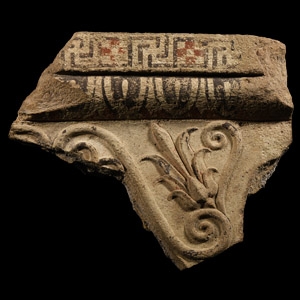
.jpg)


.jpg)
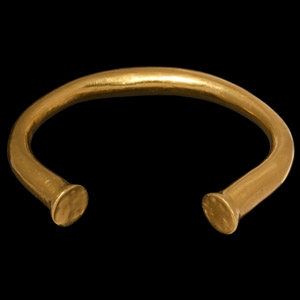
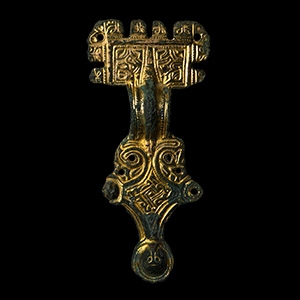

.jpg)
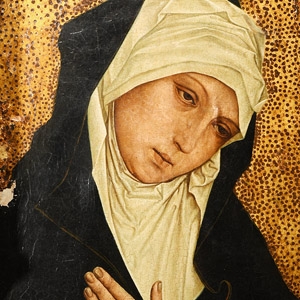

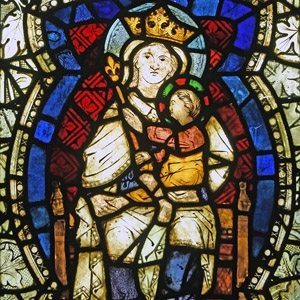
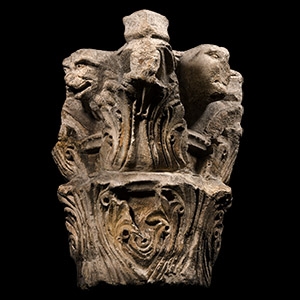
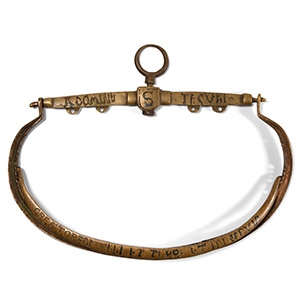
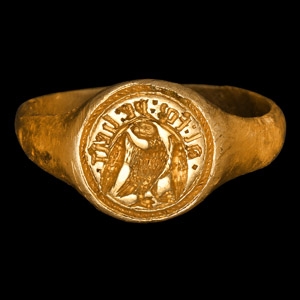
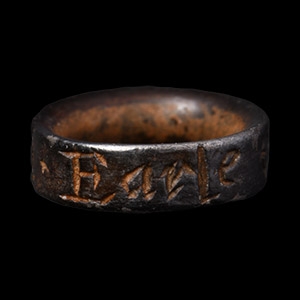
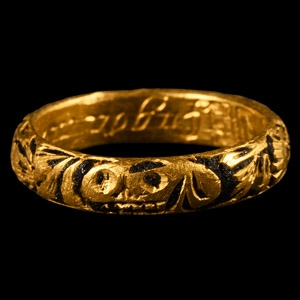
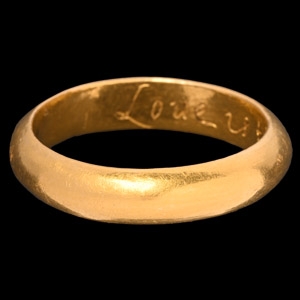
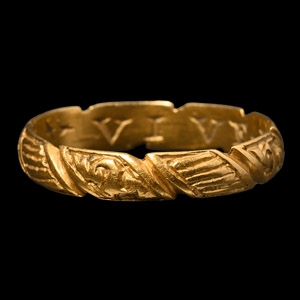
![English Milled Coins - George VI - 1937 - Cased RM Proof Coronation Gold Set [4] English Milled Coins - George VI - 1937 - Cased RM Proof Coronation Gold Set [4]](https://timelineauctions.com/upload/images/items/small/203351-s(2).jpg)
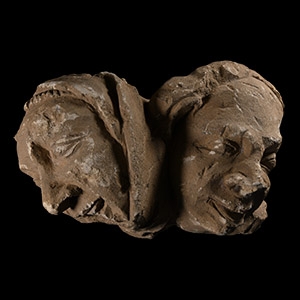
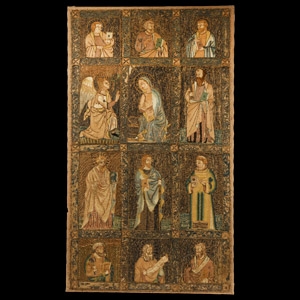
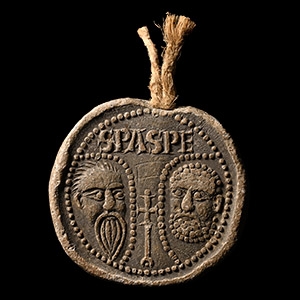
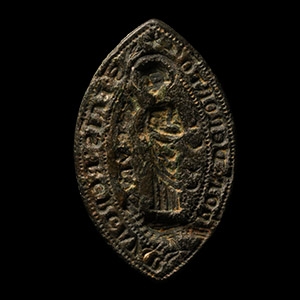
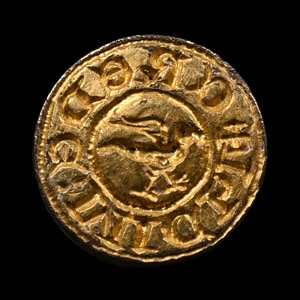
.jpg)
.jpg)

